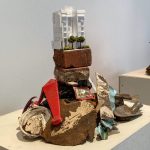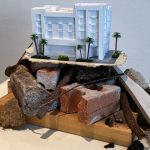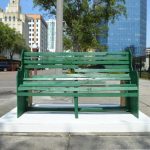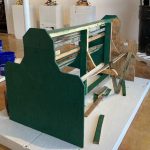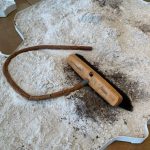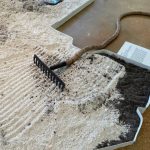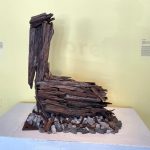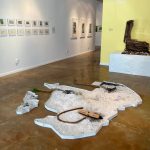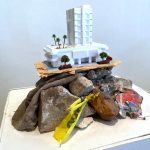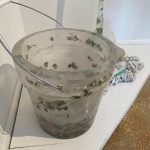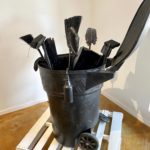QUINTON MERADA SOLO EXHIBITION
Exhibition Statement
Quinton Merada uses his Art to Explore Social Challenges Through History and Future Visioning for St. Pete
Quinton Merada is a native of Pinellas Park. His mom has been an educator for over 30 years and his dad is intimate with warehouse work and manual labor after over 38 years at UPS. Merada approaches his art and knowledge of the working class through the lens of knowing the ups and downs of economic cycles. His roots and affinity for St. Petersburg and the region run deep. He hopes for a better future for the area and expresses that through his art.
Merada will have a solo exhibition titled “Sunshine City” at the Morean Arts Center, opening July 11 and running thru September 25. Each of the works in the collection will reflect a point in the City’s history. One of the featured sculptures is a green bench echoing the Central Avenue icons that stretched along sidewalks from the 1920s to 1960s.” I built my own version of the bench, that isn’t perfect, structurally unstable, and filled with nails. I did this using found wood that was sourced from the segregation line starting at 22nd Ave S. People’s old fences and parts of buildings that have their
own history,” explained Merada. “People of color were not allowed to use the Green Benches in Downtown. There was a segregation line that limited people of color to only work in Downtown and not be able to experience the benefits of their work in hotels, restaurants, and other laborious jobs in the city. This is a constant struggle for working-class people of color. The bench was an attraction to the city but in reality, a large portion of the city’s working-class citizens couldn’t even use the benches because of their race and social status.”
Merada was always drawn to create and studied arts at John Hopkins Middle School and the Pinellas County Center for the Arts at Gibbs High School. He began studies of engineering at University of Florida before being called back to the Arts. His BFA earned in sculpture at the University of Florida fueled Merada’s orientation to use art to make a statement or as a vehicle for activism. “The service industry is the new working class,” he said. “I’m intrigued with how jobs affect economic and social status. We are seeing that work come full circle here now. What were unskilled worker positions have become ‘essential workers’ now. But the challenge of appropriately rewarding, recognizing, or paying a living wage remains,” added Merada.
The exhibition will also feature a pelican constructed from the wood of railroad ties. Merada works with found objects and tries to transfer their stories into his art. “The City of St. Petersburg rose up from the railroad, but people who built the rails were taken advantage of.” The theme of provoking discussion about gentrification and what society defines as progress is also reflected in his three pedestals described by the artist as “haphazardly” pieced together with found objects and precariously supporting piles of rubble crowned with architectural models. “We are pushing the people who make the City what it is out of the area. Florida is notoriously blind to the working class and the real costs of living. I have one sculpture featuring a resin cast bucket and mop. In the resin filled bucket you can see the representation of the minimum wage,” he added.
Merada believes that art should be a little risky. He worked for a time as a substitute teacher and hopes that by using art to reflect on history and what actually happened, he can create environments for learning, education and growth. He has constructed a shallow pool that is an outline of the map of St. Petersburg and St. Pete Beach. Gathering sand and dirt from significant locations he will install a base layer of dirt and top layer of sand within the borders of the maps, then use parts of tools, rakes, and shovels, representing construction to mix the dirt and soil. “The wood handles have been restructured like wooden snake toys. They will mix up and slice into the layers,” said Merada. “I want to recognize the divide between the dirt and sand, the beaches of affluence and the inland dirt of workers who sustain the tourism industry and luxury lifestyles while expressing hope for the future, with more mixing up of the layers.”
His stark black and white execution of the sculpture Sanitation Strike is an example of his interest in borrowing from the past to explore the present and future. The piece honors a three-month long strike, organized by Joe Savage in 1968. The sanitation department was mostly staffed with people of color who were being paid low wages and required to work 48-hour work weeks. “They felt like they were being used,” said Merada. “They organized marches and protested at City Hall. It started peacefully and then exploded in riots. At the end of the third month they had better wages and a proper work week. What have we learned or what might we learn from that history?”
In recognition of the critical role that tourism plays in the regional economy Merada has also done a series of interviews and artwork that is evocative of a vintage postcard style. Yet the voices of those interviewed and the intimate yet satirical pieces offer commentary on the challenges of Black Lives Matter and COVID-19 today. “I like to draw from what is fact and history. Something that is actual history, cannot be a harsh social stance where someone completely hates because they disagree. It is just a fact. I seek to illuminate the educational value and how it correlates to our social environment now.”
Merada tries to live his life in alignment with his art. “I asked each individual who contributed to interviews for the postcard series to name a charity working to make things better. If those pieces sell from the exhibition, the monies will be directly donated to those named charities,” said Merada.
The galleries of the Morean Arts Center are open 10 am to 5 pm Monday thru Saturday, 12 noon to 5 pm on Sundays, and remain closed for 4th of July and Labor Day this summer. The Sunshine City exhibition opening on July 11 will be extended thru September 25.
